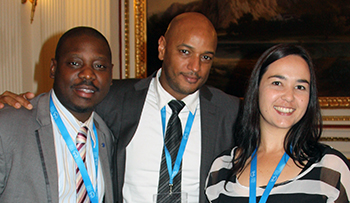UFS chemist invited by UNESCO to present lecture at World Science Forum in Budapest

From the left are: Dr Jean-Paul Ngome Abiaga from UNESCO, France; Abdoulaye Ibrahim, also from UNESCO in France; and Truidie Venter, a young scientist from the Department of Chemistry at the UFS.
Photo: Supplied |
Dr Truidie Venter, a young scientist from Inorganic Chemistry in the Department of Chemistry at the University of the Free State (UFS), returned recently from presenting a lecture at the 7th World Science Forum, held in Budapest, Hungary. She was one of the few young researchers world-wide who were invited to attend the forum.
In her capacity as a young female researcher from Africa, Truidie was invited by UNESCO to present her views on science in diplomacy at this event. Her talk focused on collaboration between researchers from different countries, and the challenges faced by young researchers in Africa, and served to initiate discussions between young researchers concerning international, interdisciplinary scientific cooperation.
The Science Forum, an international conference dedicated to science and knowledge, was held in Budapest from 4-7 November 2015. This interdisciplinary gathering is supported by the United Nations Educational, Scientific and Cultural Organization (UNESCO), the International Council for Science (ICSU), and other partners, and is aimed at providing an occasion for representatives of science, politics, international organisations, industrial and financial decision makers, international science forums, and science academies to meet and exchange views.
More than nine hundred delegates from 108 countries took part in this event. The speakers included Her Royal Majesty Princess Sumaya Bint El Hassan, President of the Royal Scientific Society of Jordan, Dr Irina Bokova, the Director-General of UNESCO, Prof Sir Peter Gluckman, first Chief Science Advisor to the Prime Minister of New Zealand, Prof Ene Ergma, former President of the Riigikogu (Estonian Parliament), and Ms Naledi Pandor, Minister of Science and Technology of South Africa.
At the conclusion of the forum, a declaration was accepted regarding the renewal of the scientific community’s commitment to the responsible and ethical use of scientific knowledge in addressing the grand challenges of humankind. This declaration addressed the headings of climate change, new sustainable development paths, disaster risk reduction, scientific advice for policies, international collaboration for capacity-building and mobilisation in the developing world, and balanced investment in science.